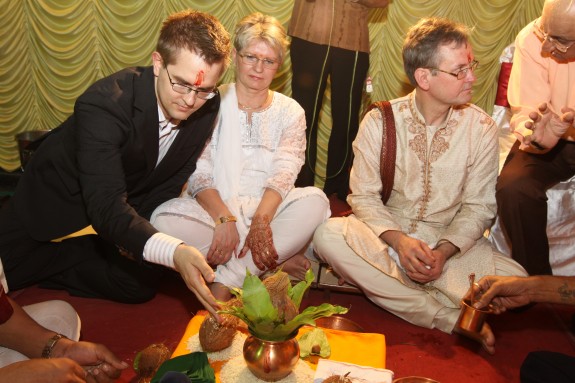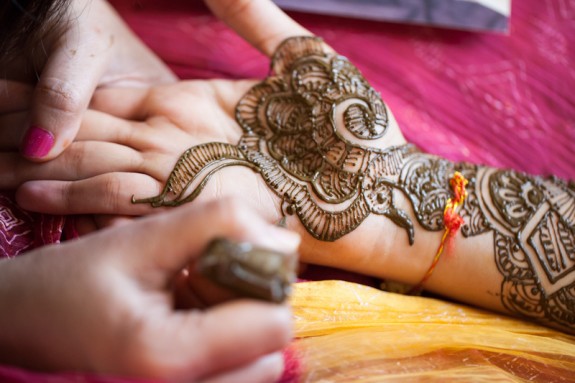Maharashtrian weddings are filled with various pujas and religious rituals – but we are here to make the whole process simple and easy to understand.
Be sure to check out the rest of our Maharastrian Wedding series below:
Maharashtrian Wedding: Introduction
Maharashtrian Engagement/Pre-Wedding Traditions – You are here!
Maharashtrian Wedding Traditions
Maharashtrian Post-Wedding Traditions
Maharashtrian Food and Desserts
Horoscope
The first step of a Maharashtrian engagement involves the families ensuring they are not part of the same gautra. The gautra is the family lineage. For genetic and familial reasons, Maharashtrians do not marry in the same lineage.
If the gautras are different, then a pundit is brought over to review the couple’s horoscope. Before the wedding date is finalized, a priest must compare the bride’s astrological sign with the groom’s to determine if they are a good match.
Some Maharashtrian marriages are arranged for the bride and groom by their parents, who take a careful look at the couple’s horoscope before planning the wedding. They want to make sure that the stars are aligned to bring the bride and groom the best possible luck in marriage.
Even couples who are having a love marriage can still have their horoscopes read. A pundit is called to the house of the bride to decide an auspicious date for the wedding ceremony to occur. This date is also based on both the bride’s and groom’s astrological signs.
Kelvan
When the stars, moons, and sun align for a wedding date for the couple, and both sides of the family agree, they have the kelvan.
A prayer to the family kuldevta, or family deity, is practiced by both the bride and the groom’s side. Usually a priest is also called to perform a puja where both sides of the family attend.
Sakhar Puda
The “sakhar puda” – which literally means “sugar puja,” occurs a few weeks/months after the kelvan. It is the engagement ceremony for the Maharashtrians and is the first puja in the wedding celebrations. The respective families of the bride and the groom feed each other sugar to celebrate the union.

It is supposed to symbolize a “sweet” ceremony and a marriage to follow! After the prayers are completed in the morning, a family lunch follows.
Wedding Invitations
A few weeks or months before the wedding, wedding invitations are sent out. Families first go to their devas to invite and be blessed by the gods. Then each family visits the elders and important family members and personally invites them to attend the wedding of their child. This is both a social and religious obligation for families.
The week of the wedding:
Munja
The munja, also known as Upanayana in Hindi, is the thread ceremony for boys. Boys, around eight or nine years old, receive threads, zanaave, as a way of receiving spiritual knowledge from their priests, their parents, and their books.
For men who did not have a munja as a child, a munja ceremony will take place before the wedding for him. It is a way of ‘catching up’ for missing the childhood ceremony.
While many men do not wear their threads on a daily basis, once the groom is married, he will receive a second thread to wear, indicating his wedded status.
Haldi Chadhavat
A day before the ceremony, haldi (turmeric paste with mango leaves) is applied to the bride and groom. Like at all Hindi pujas, the haldi ceremony begins with a simple puja to bless each person.
The haldi is applied to the feet, hands, and face of the bride (in that order which is known as the chadhavat). Haldi makes the bride’s skin glow, so she looks extra-beautiful for her big day. The ceremony is conducted at the home of the bride as well as the home of the groom, respectively.
Once the haldi ceremony is complete, neither the bride nor the groom are supposed to leave their respective houses until the day of the wedding ceremony. It’s considered bad luck otherwise!
After the haldi is applied, the bride’s friends and female relatives help her to wash off. They throw cold water on her as she sits on a stool in the bathroom, and they each take turns “cleansing” her (which is fun for everyone). Afterwards, the bride scrubs off all the excess haldi with a long bath.
Mehendi
While the concept of mehendi originated from the Persian Empire, the art flourished across every region in India.
The bride’s hands and feet are painted with a paste in elaborate designs of paisley, exotic birds, and gods. She is even supposed to have her groom’s name engraved within the designs – so he can search her hands for it all night!
Suvasini Puja
After all the engagement rituals have been completed, the wedding is ready to begin! Many more pujas, fun traditions, and family bonding is to follow in the Wedding Traditions.


